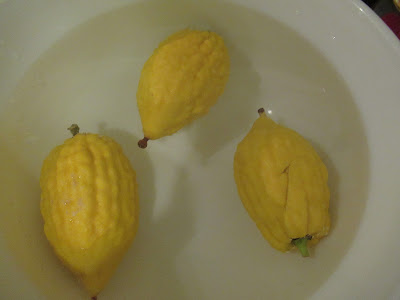One traditional thing to do after Sukkot is to make etrog jam. During non-pandemic years I can ask my friends after services if they are willing to give me their etrogim which have outlived their ritual purpose. This year I posted my request on Facebook.
A dear friend responded with alarm. She noted that etrogim are sprayed with lots of pesticides because their only job is to look pretty. She was worried that eating the etrog jam might be a risky thing to do. I thought about what my wise friend said and I thought about old etrog jam recipes. They usually have you soak the etrogim in water, and changing the water for several days before making the jam.
Two friends gave us their etrogim. I put all three etrogim into a big bowl with water. I noticed that
the water smelled a little like gasoline and not citrussy. I changed the water every time I walked past the bowl. The water smelled like gasoline for several days. I figured that the bad stuff was leaching out of the etrogim and into the water. After five days the etrogim no longer smelled like a gas station but instead had that wonderful familiar citrus scent. I made a small batch of jam and gave away a jar each to my friends who had donated their etrogim to the cause.After soaking the etrogim they are cut up and are boiled five times in water and then the water is drained off after each boil. I figure that between all of the water changes all of the bad stuff that had been sprayed on the etrogim has probably been poured down my sink.
My old cookbooks usually tell you to weigh the peels and then add the same amount of sugar to the pot and then there is some sort of a calculation about how much water to add. I did no such calculations. There were a ton of cut up etrog peels. I added four cups of sugar and a bunch of water. I simmered the mixture until it was thick.
I scalded my jars and the lids with boiling water and then added the still-hot jam and closed the lids. I store the jam in the fridge and I usually finish off the last bit on Tu B'Shvat, the new year of the trees.
I had given away two eight-ounce jars from the earlier batch. This is my stash of etrog jam. The large jars are 32 ounces each.
The mustard jar holds 16 ounces and the small jar about four.
I love that the taste of Sukkot will last us until the very beginning of spring.





I once travel from Louisiana to Texas to buy an etrog tree. It never made a fruit in the 7 years I had it. But Zaide Rueven gave me a nice little book on the history of the etrog, and biblical texts, anatomy and recipes, including your jam, and also candied , schnapps, and stewed with brown sugar and vanilla. It is out of print now, but a very informative little book. I am jealous you have access to so many estrogim. I do love your blog.
ReplyDeleteSo happy that you stop by to read.
ReplyDeleteYour etrog book sounds wonderful! I have in the past made etrog booze. candied orange peels are really similar to jam in terms of the making, you add a last step of drying out the peels in the oven.
I was surprised to have quite so many etrogim this year and so may super large ones. other years I have added other citrus peels to my jam. This year there was one lone thick skinned orange.